
Features
MRO
Older Aircraft Maintenance: Save up front but beware the costs
Corporate aviation continues its record growth rate in
Canada. The Canadian Business Aviation Association reports the Private Operator Certificate (POC) program that it administers is growing at 10% per year for new or expanding operators.
March 28, 2008 By Rob Seaman
Corporate aviation continues its record growth rate in Canada. The Canadian Business Aviation Association reports the Private Operator Certificate (POC) program that it administers is growing at 10% per year for new or expanding operators.
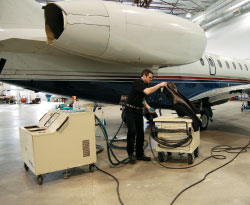 |
| Toronto-based MX Aerospace is a new maintenance and repair facility. One of its special areas of interest is “legacy” type aircraft. |
That’s perhaps only a couple of dozen or so new aircraft per year in our relatively small market, but the number of business-focused, pressurized, turbine-powered aircraft has more than doubled in the last few years. The CBAA program was developed for 135 POCs at the start, with modest growth expected from there. Today there are 306 POCs in Canada. Still more significant is that not all of the aircraft involved are factory-new deliveries – most are a resale of some sort.
Price is a frequent factor in the decision to buy an older aircraft. Many older aircraft now cost considerably less to acquire than they did a year or two ago – and in many cases they are older variants of Learjets, Challengers, Falcons and Cessnas that represent value in today’s market. Being “experienced,” as some brokers like to say, makes them an attractive option for those who have determined the need for a corporate aircraft but don’t have the resources or perhaps the time to wait for a factory-fresh delivery.
Depending on the age of the aircraft, they may still have some sort of warranty attached to them for their new owners. Most OEM warranty periods go for about five years but their support and responsibility for oversight of the product extends well beyond a warranty. And there are of course parts and engine support programs that can and do continue beyond the factory warranty period. Such things have an impact on the value of the aircraft.
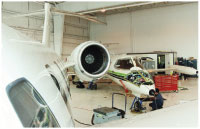 |
| Being “experienced,” as some brokers like to say, makes older aircraft an attractive option for those who don’t have the resources or perhaps the time to wait for a factory-fresh delivery. |
When does on older aircraft become too old? Even older aircraft can have many useful years of service left in them. As Paul Carter, a Toronto-based corporate aviation importation and maintenance specialist, says: “Shelf life for an airframe is a tricky question. A large number of components have finite lives placed on them by the manufacturer of these components. For structural components, such as fuselage, flight controls, etc., as long as these areas are free from corrosion and in a serviceable condition, there is really no shelf life against them. After all, DC-3s are still flying and these aircraft were built in the 1930s and 40s.”
As Carter points out, the question of usable and renewable has to deal more with the expense of maintaining the aircraft and the amount of downtime required to keep the airframe in a fit and safe condition for flight. “Even the oldest aircraft may be usable,” says Carter, “but will it make sense financially to keep them in the air?” The key issue here is that the older the airframe, the more that will be found in the inspection process and the more extensive the repairs will be.
As to the role the manufacturer has in older aircraft, as the OEM of a specific aircraft type, there are many things it is responsible for – as long as it owns the type certificate. Examples are providing support in the form of parts, service advisories, technical assistance and oversight of the aircraft. All of this is associated with the ownership of the specific aircraft type certificate. It is not uncommon for aircraft that have aged to have their type certificates sold to other manufacturers or owners over time. For example, the Israel Aircraft Industries Westwind I and Westwind II aircraft now fall under Gulfstream for support as does its more recent Astra family. This does not necessarily mean that Gulfstream is still making all the parts to support that aircraft – that role has fallen to aftermarket support providers in some cases. It does, however, mean that it is responsible for the technical support and oversight of operational issues that may require fleet attention under the issuance of a service or mandatory maintenance bulletin.
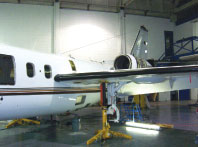 |
| Top: It is not uncommon for aircraft that have aged to have their type certificates sold to other manufacturers or owners over time. For example, the Israel Aircraft Industries Westwind I and Westwind II aircraft now fall under Gulfstream for support. Bottom: Under the experienced leadership of Bob Scott, MX Aerospace has set up shop in a central market where it felt there was a need and void for such focussed support to corporate aircraft. |
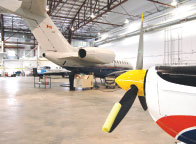 |
In some extreme cases, the OEMs are starting to pull away from some aircraft types still in service but long since out of manufacture. Last year, for example, Lockheed Martin got a lot of attention when it said it plans to issue revisions that limit the life for wing attachment bolts, tail pivot fittings, flaps and nose wheel steering on its first-generation bizjets. Such repairs could, say some service experts, potentially cost operators almost one third to a full half of the current book value of their aircraft. There are in many cases alternative parts sources for older aircraft that can represent cost savings. However, in the case of the JetStar, the replacement parts do not exist yet and given the relatively small number of them still in service, it is not likely that many aftermarket parts manufacturers will tool up to make these items. There are simply not enough aircraft out there to justify the initial cost and therefore the return on investment.
Engineers like Gord Williams, a Field service representative under contract to Bombardier, and others in the industry from GAMA (General Aviation Manufacturers Association) through to the FAA and Transport Canada are all looking at the older-aircraft issue with new eyes these days. As both Williams and Paul Carter point out, as older aircraft are updated we will see more and more deterioration in wiring for primary systems. In fact, they point out that a large number of 25- to 35-year-old corporate jets still have the original engine and aircraft wiring systems installed. And as we all know, wire does not last forever, so to undertake the complete rewiring of a JetStar or even an old Lear 25 is a huge and costly undertaking. Who is going to engineer the NDT (non-destructive testing) techniques for inspecting the spars on older out-of-production aircraft that don’t have a set life? Who has the funds for that? And when will it be due? All these are questions that are increasingly being asked.
While nobody has yet been totally left out in the cold where maintenance for their older airframe is concerned, there have been reports of some service centres shying away from the older aircraft, citing possible liability concerns. But this has also spurred the development of service specialists who embrace redevelopment and support of older aircraft. In Wichita, for example, Yingling Aviation came out swinging last year when it announced that it loves older “legacy” models of Cessna aircraft. Lynn Nichols, president of Yingling, cites as an example its work with Cessna directly in the Spar Strap kit Cessna developed for operators of 400 series twins and Conquest turboprops. Yingling’s maintenance team assisted Cessna’s engineers on just what was needed to install these kits, such as time studies, methodologies and procedures. That’s a program that is directed specifically to older airplanes which may have developed fatigue cracks over a period of extended service. Says Nichols, “the Cessna Aircraft Company takes a serious and proactive approach in supporting legacy aircraft. And we take great pride in helping operators of legacy aircraft extend the life and usefulness of their airplanes.”
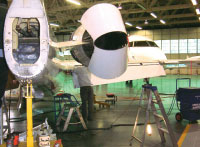 |
| An older aircraft can represent a great opportunity for gaining the benefits associated with corporate aviation. |
Closer to home there is a new welcome sign alight for older-aircraft service. It is Mississauga-based MX Aerospace Services. Calling Hangar 9 at Pearson International Airport home, MX COO Bob Scott and his team have brought together experience and maintenance capability through professionals who are focused on high-end support and service that all aircraft need – but older airframes in particular demand. Scott says they found that in this area for older aircraft, there was a lack of both a facility and the positive attitude that could provide the right balance of service expertise and sensitivity. “I truly believe that both new and used aircraft owners and operators are becoming increasingly more sophisticated with their understanding of the process for maintaining their assets. They are equally concerned with some existing ideals of throwing capital at a problem until it goes away. There should be a balance between the ideals of who’s proposing work scopes versus who’s funding these decisions, regulatory concerns, asset value initiatives and operational objectives. These ideals can become increasingly distorted when older aircraft become the focal point. Without a clear understanding between the owners and support facilities and a healthy respect for each other’s objectives, costs can become unrestrained with the unfortunate default back to the aircraft principal to subsidize improperly assessed exposures.”
Combining the proper support and equipment and a reasonable approach to budgets, Scott feels that MX differentiates its centre from others with the seen and unseen things. Attitude and business approach are part of the mix. It sees older aircraft as an opportunity. “MX is not just about fixing it today,” says Scott. “We are here to service and support for today, tomorrow and as long as you own the aircraft.”
Bombardier came under some heat last year when it announced that it would start charging for some aspects of support for its older aircraft. One of Gord Williams’ recent projects with Bombardier involved just this subject. As Williams explains it, Bombardier has fully supported all its product lines, but more recently it has become difficult to run a 24-hour-a-day AOG (aircraft on the ground) hot line while it was getting 30 to 50 calls a week from third-party maintenance facilities requesting Bombardier support. These calls were typically requests for in-depth troubleshooting that were going to the Bombardier hot line techs. They found that in many cases the callers had received no type training or were asking for copies of manuals they had not purchased. These calls tied up personnel who were set up specifically to address customer AOG situations. This is the main reason that the OEM launched what it refers to as its Classic Program.
An aircraft is designated “Classic” 10 years after the last serial number of a specific model is delivered. Classic aircraft include all Learjet models manufactured prior to, and including, the Learjet 31 (but excluding the Learjet 31A) as well as the Challenger 600, 601-1A, 601-3A and 601-3R.
Bombardier says that as its aircraft fleets age, the need for engineering and technical support resources is growing to stay current on relevant technology and to provide support for parts that are no longer in production. To sustain support to aging product lines, customers have been charged for technical support and service of their Classic aircraft since September 1, 2007.
Every day Bombardier continues to assist 600/601 customers with problems that, if caused by a customer’s inability to locate a part, is done at “no charge.” However, a database is kept and for constant callers, remedial training is suggested. As Williams concludes, with all “current production aircraft” like the Global Express, Challenger 604/605 and Challenger 300, if 600/601 customers request engineering support and it’s not a warranty request, they will be charged the current rate as per a published rate card.
An older aircraft can represent a great opportunity for gaining the benefits associated with corporate aviation. It can also be a nightmare and a money pit if not handled correctly. The trick is to buy well up front, manage and maintain properly and go into this sort of ownership fully prepped for the good and bad things. And most important – have the money and mind-set to support it all.